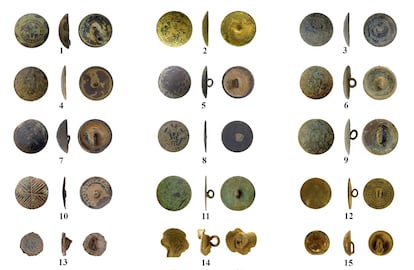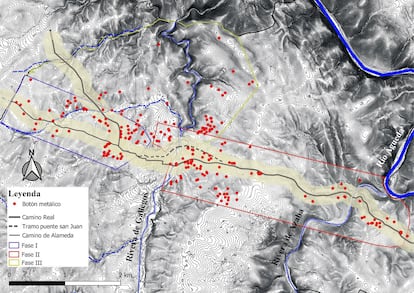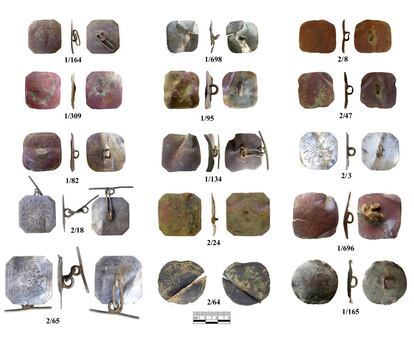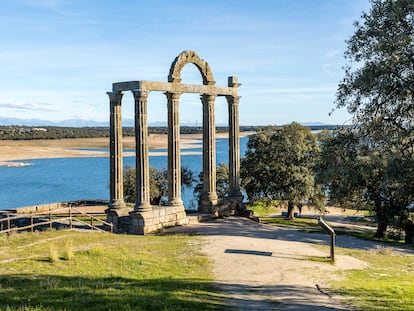Three hundred years of war stories as told by lost buttons
Mundane clothing fasteners excavated from Spanish battlefields provide glimpses into the country’s many clashes with Portugal, England and France

Gallegos de Argañán is a small municipality in the province of Salamanca (western Spain), about nine miles (15 kilometers) from Ciudad Rodrigo and six miles (10 kilometers) from the Portuguese border. Its strategic location next to an old royal road meant that it was traversed many times between the 17th and 19th centuries by a wide variety of military forces: Spanish “Tercios” (elite army units), battalions and regiments, Portuguese “caçadores” (light infantry), English divisions and Napoleonic army brigades. Every one of these military forces consisted of soldiers who crouched, crawled, rested, fought and sometimes died on battlefields, tearing buttons and paraphernalia from their uniforms along the way.
Clemente González García, an archaeologist specializing in battlefield excavation, recently published his latest findings in the Revista Numismatica Hecate numismatics journal. His report focuses on metal buttons from military uniforms of the 18th and 19th centuries excavated in the vicinity of Gallegos de Argañán. It’s a trail of breadcrumbs that González followed for three years while he documented and researched 3,200 different objects unearthed along more than four miles (seven kilometers) of road. The monumental effort enabled González to identify the exact places where exhausted soldiers once stopped to rest or were felled in combat.
“The enormous amount of traffic over this road by ordinary people and military forces resulted in the loss of many metallic objects. These included a great variety of buttons that are often difficult to identify and categorize chronologically.” One of the challenges is that it’s difficult to determine whether the object belonged to a civilian or a soldier. Metal buttons were only used on military uniforms starting in the late 17th century, and the names of specific units were not stamped on buttons until 1784.
“Buttonology” is a branch of numismatics that studies buttons in order to date and reconstruct historical events from the specimens found. Of the 3,200 objects recovered by González, 1,100 are ball-type bullets used by muzzle-loaded weapons, 700 coins, almost 100 belt buckles, and religious medals, thimbles, various ornaments, pieces of weapons and nails of all types and sizes. All these objects are evidence of “the intense human activity in this small municipality along the border with Portugal.” From this large volume of metal objects, González identified and documented 220 buttons that were later turned over to the Salamanca Museum.

This particular royal road was probably originally built by the Vettones (an Iron Age, pre-Roman people of the Iberian Peninsula), since several of their crude granite sculptures of wild boars have been found there. But it was also used by the Romans, who may have called it the Salamanca-Coimbra (Portugal) Road. During the Portuguese Restoration War(1640-1668), the military fort at Gallegos de Argañán, which was built as a perimeter defense for Ciudad Rodrigo, was bombed by the Portuguese in 1647. During the War of Spanish Succession (1704-1714) between the Habsburg and Bourbon dynasties, the area was attacked repeatedly by Hapsburg artillery, who later controlled the area for almost 18 months. In 1736, another large fortress was built in Aldea del Obispo, just nine miles (15 kilometers) from Gallegos de Argañán. For several decades, the fortress construction required transporting huge quantities of raw materials such as lime, bricks, stone, iron, firewood, tools, supplies along the royal road, including soldiers and their horses.
In 1762, the Spanish monarchy invaded Portugal and triggered the so-called Fantastic War, suffering heavy losses and ultimate defeat. Cavalry regiments from Flanders, Milan, Granada and Bourbonnais marched over the road, as did dragoons from Merida and Sagunto, and 8,000 French soldiers dispatched by the Prince de Beauvau. In May 1801, during the brief War of the Oranges, another large French contingent passed through the area. In 1810, Napoleon’s troops besieged Ciudad Rodrigo, while the English Light Division stationed in Gallegos de Argañán covered the retreat of Wellington’s army. In 1811, the battle of Fuentes de Oñoro was fought in a neighboring town. In 1812, Ciudad Rodrigo was once again under siege, this time by English forces led by General Wellington, who used Gallegos as a logistical base and camp for thousands of men. When the N-620 road was built in the mid-20th century, the centuries-long traffic of soldiers and goods through Gallegos finally began to disappear.

Unlike coins, buttons are attached to clothing, which greatly reduces the chances of losing one. For one to come off, it has to be pulled with sufficient force. This often happens during battles, but also in the army camps where soldiers slept and ate.
The vast majority (91%) of the buttons found were made of copper alloys, but a few were made of pewter (lead and tin), tombac (brass and zinc), and aluminum. Most were flat buttons, but a quarter had a convex shape. Spherical and semi-spherical buttons were the least common. Most are round, except for a few octagonal buttons. Not a single “charro” button was found, probably because these were mostly decorative and not used for everyday clothing.
Several 19th-century Spanish infantry buttons were found. Some that were issued between 1875 and 1931 depict the crown of the Alfonso monarchy, but others bear the First Spanish Republic’s coat of arms. These include pieces from the “Carabineros,” who were responsible for controlling smuggling along the border, the Spanish Armada; the “Cazadores de Barbastro” battalion; the Savoia Cavalry Regiment (Tuscany, Italy); and the Provincial Militias of Ciudad Rodrigo.
The collection includes buttons from “Vendée” and “patriotic” soldiers. The first group fought in the civil war between royalists and republicans that took place in the French province of La Vendée in 1793. These buttons may have been worn by Napoleonic troops that fought near Gallegos since they were found next to the ball-type ammunition used at the time. The buttons from the “patriotic” soldiers depict busts of King Ferdinand VII and Queen Isabella II, an imitation of French buttons bearing Napoleon’s bust.
In October 1808, 12,000 English soldiers disembarked at the port of A Coruña (northwest Spain) and crossed Salamanca toward the Portuguese border, many of them accompanied by women. They remained in the area until 1813, living in camps, manning sentry posts and battling the French. They even turned the local hermitage into a theater for performances by British officers dressed as women. English laws were very strict about the quality of the gold plating on uniform buttons, and many soldiers resorted to using them as currency in Spanish taverns.
One of the most remarkable English buttons found in Gallegos bears a star radiating eight beams of light and a cross in the center, surrounded by the Most Noble Order of the Garter motto: Honi soit qui mal y pense (Middle French for ‘Shame on him who thinks evil of it’). The Order of the Garter is the most senior order of knighthood in the British honors system. The button belonged to an officer of the Coldstream Guards who fought in the battle of Fuentes de Oñoro in May 1811. Also found were similar buttons from the Royal Dragoons (part of the Light Division First Brigade), and from the 43rd Regiment (infantry). One of the buttons displays the Prince of Wales’s feathers and motto, Ich dien (“I serve” in German).
Buttons from French soldiers include 17 pieces from infantry and cavalry units, as well as from the 15th, 24th, 26th, 26th, 39th, 76th, 82nd and 86th regiments. One outstanding example is from the 3rd Flotille Battalion, which was created in 1807 to crew the French flotilla gunboats.
A large number of buttons decorated with floral motifs and crosses were initially thought to belong to civilians. However, the large number found in proximity to other military artifacts indicate that they were used by the Spanish “Tercios” troops in the first half of the 18th century.
González’s report notes the harm caused by artifact hunters and looters using metal detectors. “Suffice it to say that the 600 hours we spent in the field to unearth about 3,200 objects is roughly equivalent to a single amateur prospector spending every weekend afternoon with a metal detector hunting artifacts for a year. Multiplied by the hundreds or thousands of amateur prospectors in Spain, the damage they cause is obviously immense, especially in Spanish battlefields.” The looting of archaeological relics – ammunition, belt buckles, coins, buttons and more – “prevents an objective reconstruction of history, which until now has been based exclusively on documentation sources.”
This kind of looting impedes the accurate and scientific study of many historical events, especially the major battles that we only know about from written accounts. History may be written by victors, but its last vestiges are undoubtedly being erased by the looters.
Sign up for our weekly newsletter to get more English-language news coverage from EL PAÍS USA Edition
Tu suscripción se está usando en otro dispositivo
¿Quieres añadir otro usuario a tu suscripción?
Si continúas leyendo en este dispositivo, no se podrá leer en el otro.
FlechaTu suscripción se está usando en otro dispositivo y solo puedes acceder a EL PAÍS desde un dispositivo a la vez.
Si quieres compartir tu cuenta, cambia tu suscripción a la modalidad Premium, así podrás añadir otro usuario. Cada uno accederá con su propia cuenta de email, lo que os permitirá personalizar vuestra experiencia en EL PAÍS.
¿Tienes una suscripción de empresa? Accede aquí para contratar más cuentas.
En el caso de no saber quién está usando tu cuenta, te recomendamos cambiar tu contraseña aquí.
Si decides continuar compartiendo tu cuenta, este mensaje se mostrará en tu dispositivo y en el de la otra persona que está usando tu cuenta de forma indefinida, afectando a tu experiencia de lectura. Puedes consultar aquí los términos y condiciones de la suscripción digital.
More information
Últimas noticias
David Bowie, the galactic thinker who encouraged us to break new ground
John Berger and the loss of rural culture
From police officer to bloodthirsty kidnapper: Terror in Mexico during the years of ‘The Ear Chopper’
Alain Aspect, Nobel laureate in physics: ‘Einstein was so smart that he would have had to recognize quantum entanglement’
Most viewed
- David King, chemist: ‘There are scientists studying how to cool the planet; nobody should stop these experiments from happening’
- Reinhard Genzel, Nobel laureate in physics: ‘One-minute videos will never give you the truth’
- Oona Chaplin: ‘I told James Cameron that I was living in a treehouse and starting a permaculture project with a friend’
- Mexico completes its trade shift with the entry into force of tariffs on China and countries without trade agreements
- Sinaloa Cartel war is taking its toll on Los Chapitos











































